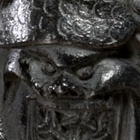J.J. Lally & Co., Oriental Art / New York City, New York
MenuPast Exhibition
Two Thousand Years of Chinese Sculpture
March 17-29, 2008
26.
A MING BRONZE FIGURE OF THE DAOIST DEITY OF THE NORTH, ZHENWU
Jiajing - Wanli Period, 16th - 17th Century
shown in military dress, standing on a snake coiled on the back of a large tortoise in a bold and resolute attitude, with sword drawn and ready, his left hand held out in front with index finger raised in a confident gesture of admonishment, his head turned sharply over one shoulder and his long hair falling straight down his back, wearing a breastplate engraved with a dragon in clouds and chain mail armor on his shoulders and legs, his wide sleeves flaring out to either side, the skirt of his robes billowing out in back and a long celestial scarf rippling over his shoulders and hanging down to his bare feet, the tortoise and snake finely detailed and showing the same martial attitude as the deity, the surface with smooth black patination.
Height 14 inches (35.6 cm)
Zhenwu, originally called Xuanwu (“Dark Warrior”), first appears in the Daoist pantheon as the embodiment of one of the four cardinal directions, representing the north, depicted emblematically as a tortoise entwined with a snake. The tortoise and snake imagery can be traced back to the late Warring States period, circa 3rd century B.C.
In the early Northern Song dynasty, the emperor Song Zhenzong (r. 998-1022) who was an ardent Daoist, decreed that the god’s name should be changed to Zhenwu (“Perfected Warrior”), and ordered a temple to be built in the Song capital city, Kaifeng, for the worship of Zhenwu, who was then represented in human form. During the Yuan dynasty, Zhenwu was elevated to the rank of celestial emperor and referred to as “Supreme Emperor of the Dark Heaven, Primal Sage, and Benevolent Majesty.”
In the early Ming dynasty, Zhenwu again was favored by the imperial house, and the early Ming emperor Yongle (r. 1403-1424) ordered the construction of many temples dedicated to Zhenwu, including the large temple which still remains as the northernmost building at the meridian of the ‘Forbidden City’ in Beijing. Zhenwu became one of the most important and most widely venerated of all the Daoist gods during the Ming dynasty and continued to be worshiped by Manchu emperors throughout the Qing dynasty.
A very similarly modelled bronze figure of Zhenwu standing on a coiled snake and a tortoise is in The British Museum, London, illustrated by Jenyns and Watson, Chinese Art, vol. 2, 2nd ed., Oxford, 1980, p. 99, no. 66.
明 嘉靖 - 萬曆 銅真武像 高 35.6 厘米
